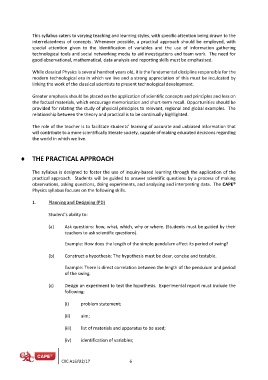Page 506 - SUBSEC October 2017_Neat
P. 506
This syllabus caters to varying teaching and learning styles, with specific attention being drawn to the
interrelatedness of concepts. Whenever possible, a practical approach should be employed, with
special attention given to the identification of variables and the use of information gathering
technological tools and social networking media to aid investigations and team work. The need for
good observational, mathematical, data analysis and reporting skills must be emphasised.
While classical Physics is several hundred years old, it is the fundamental discipline responsible for the
modern technological era in which we live and a strong appreciation of this must be inculcated by
linking the work of the classical scientists to present technological development.
Greater emphasis should be placed on the application of scientific concepts and principles and less on
the factual materials, which encourage memorisation and short-term recall. Opportunities should be
provided for relating the study of physical principles to relevant, regional and global examples. The
relationship between the theory and practical is to be continually highlighted.
The role of the teacher is to facilitate students’ learning of accurate and unbiased information that
will contribute to a more scientifically literate society, capable of making educated decisions regarding
the world in which we live.
THE PRACTICAL APPROACH
The syllabus is designed to foster the use of inquiry-based learning through the application of the
practical approach. Students will be guided to answer scientific questions by a process of making
observations, asking questions, doing experiments, and analysing and interpreting data. The CAPE®
Physics syllabus focuses on the following skills.
1. Planning and Designing (PD)
Student’s ability to:
(a) Ask questions: how, what, which, why or where. (Students must be guided by their
teachers to ask scientific questions).
Example: How does the length of the simple pendulum affect its period of swing?
(b) Construct a hypothesis: The hypothesis must be clear, concise and testable.
Example: There is direct correlation between the length of the pendulum and period
of the swing.
(c) Design an experiment to test the hypothesis. Experimental report must include the
following:
(i) problem statement;
(ii) aim;
(iii) list of materials and apparatus to be used;
(iv) identification of variables;
CXC A16/U2/17 6

